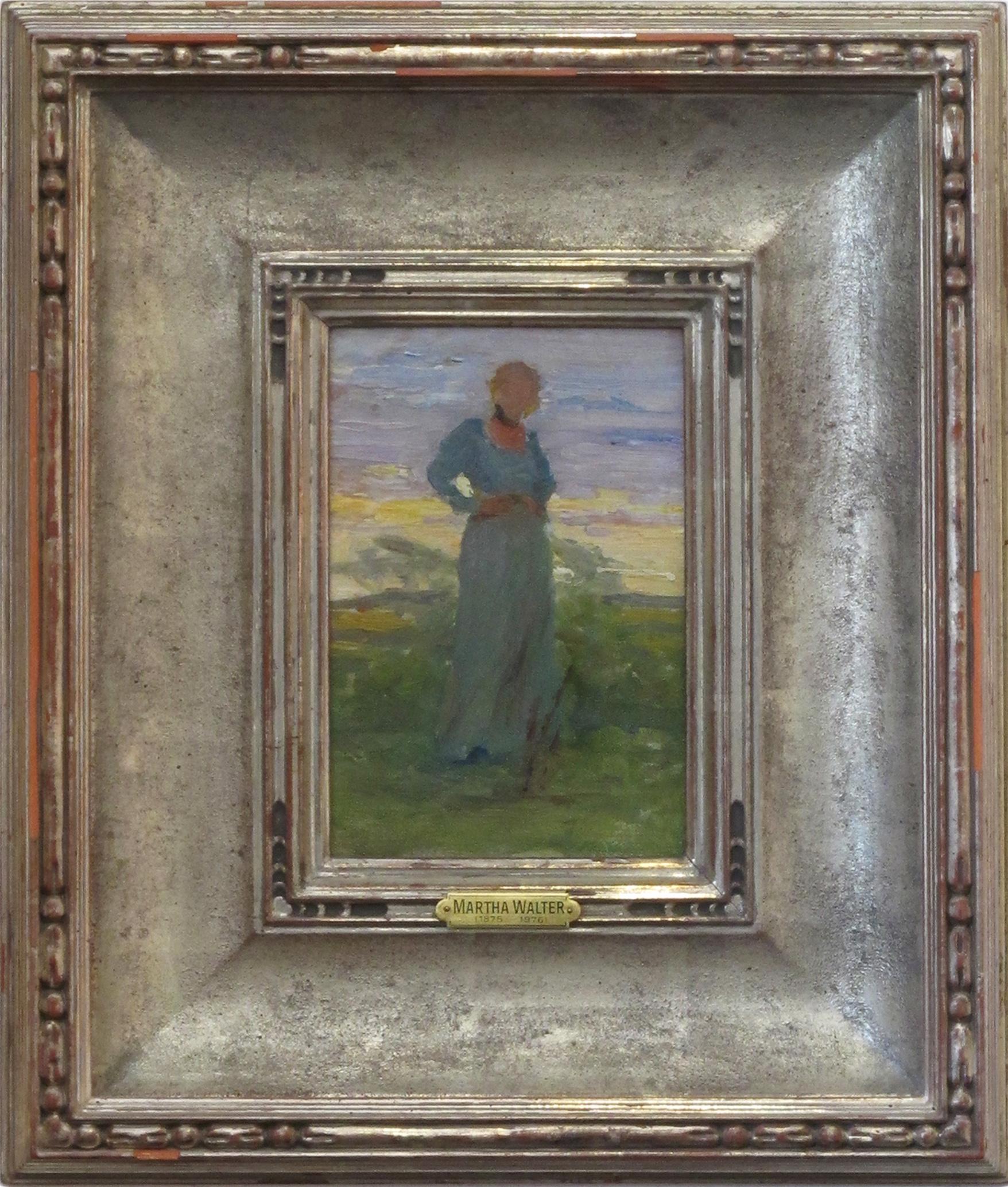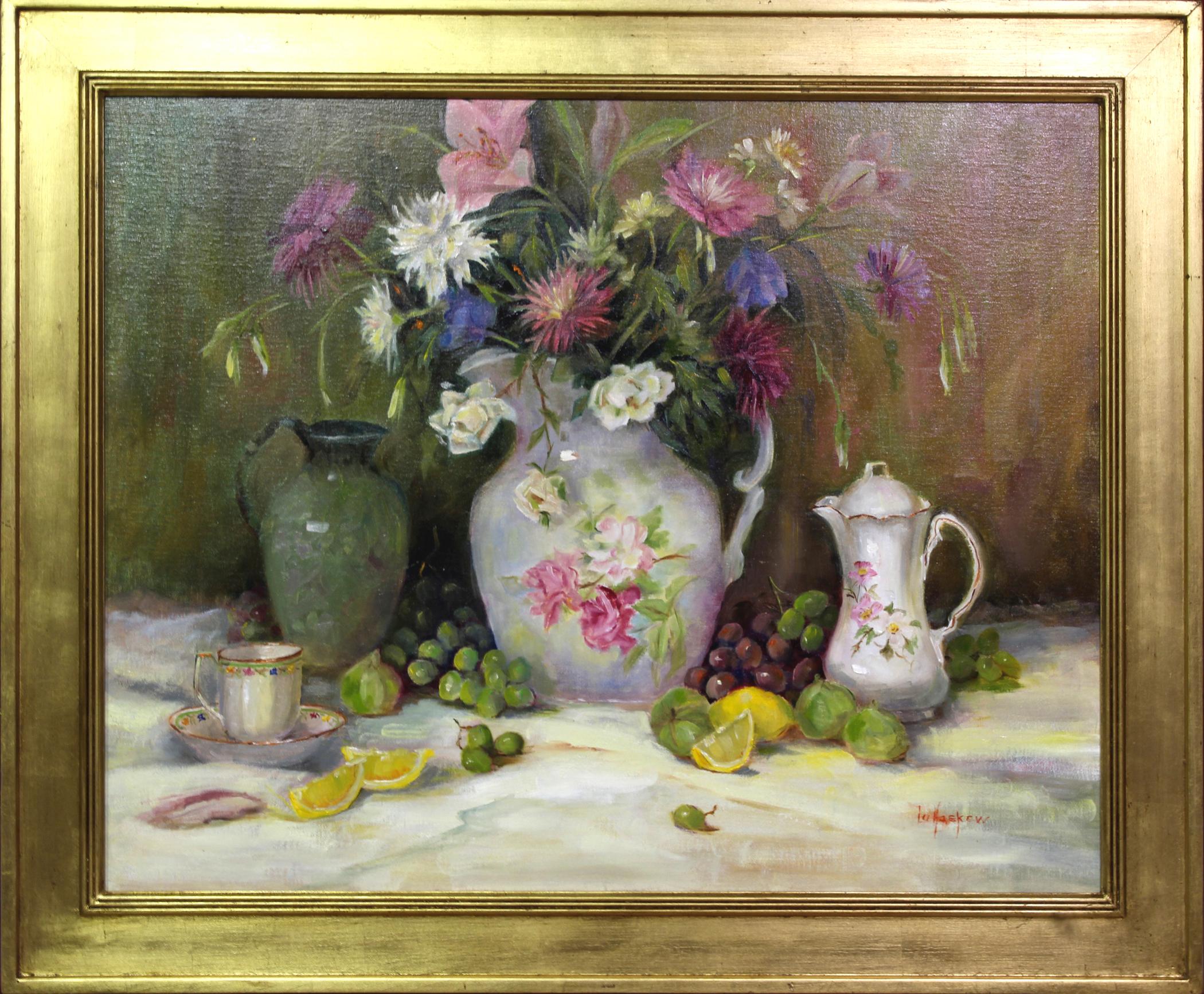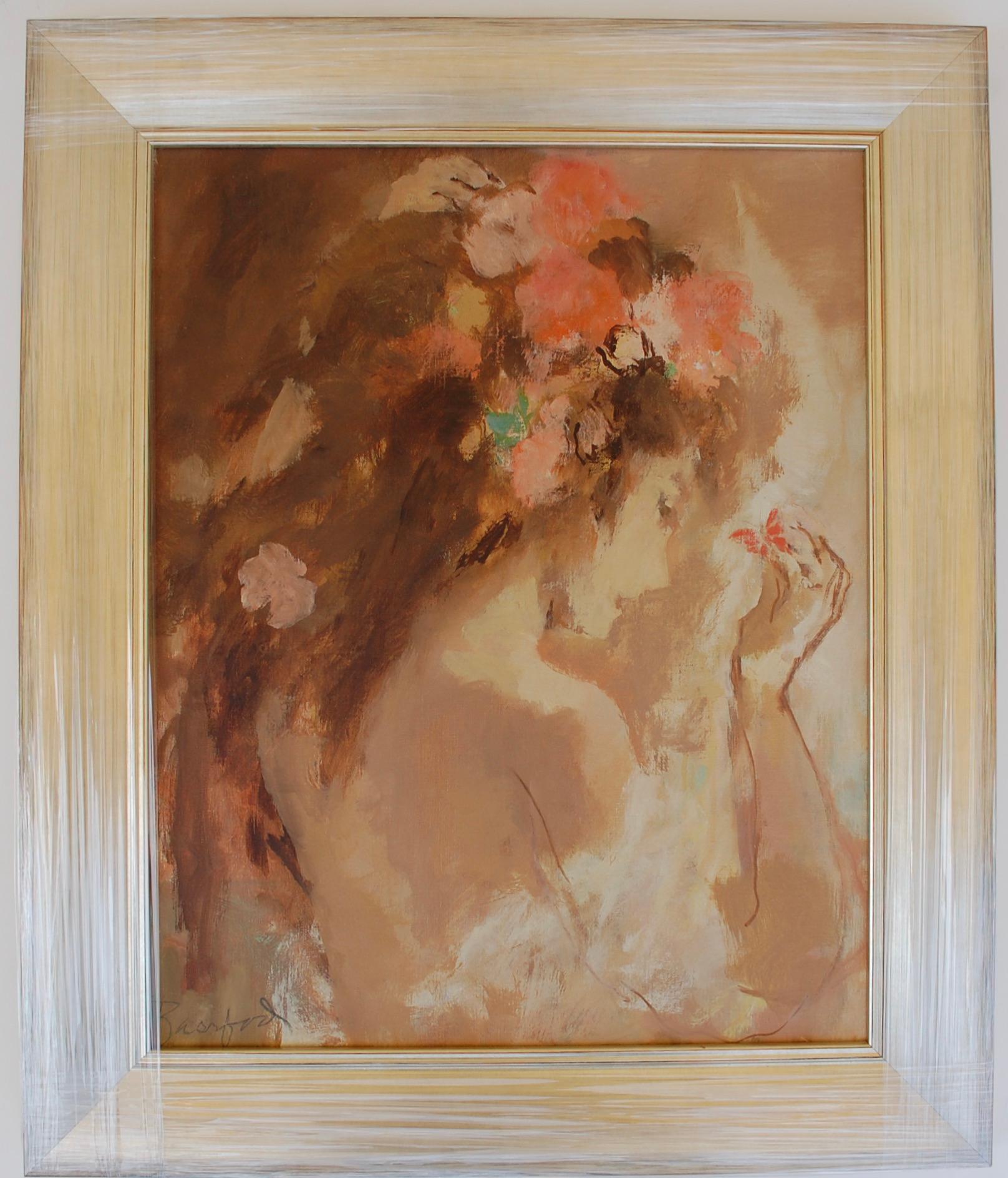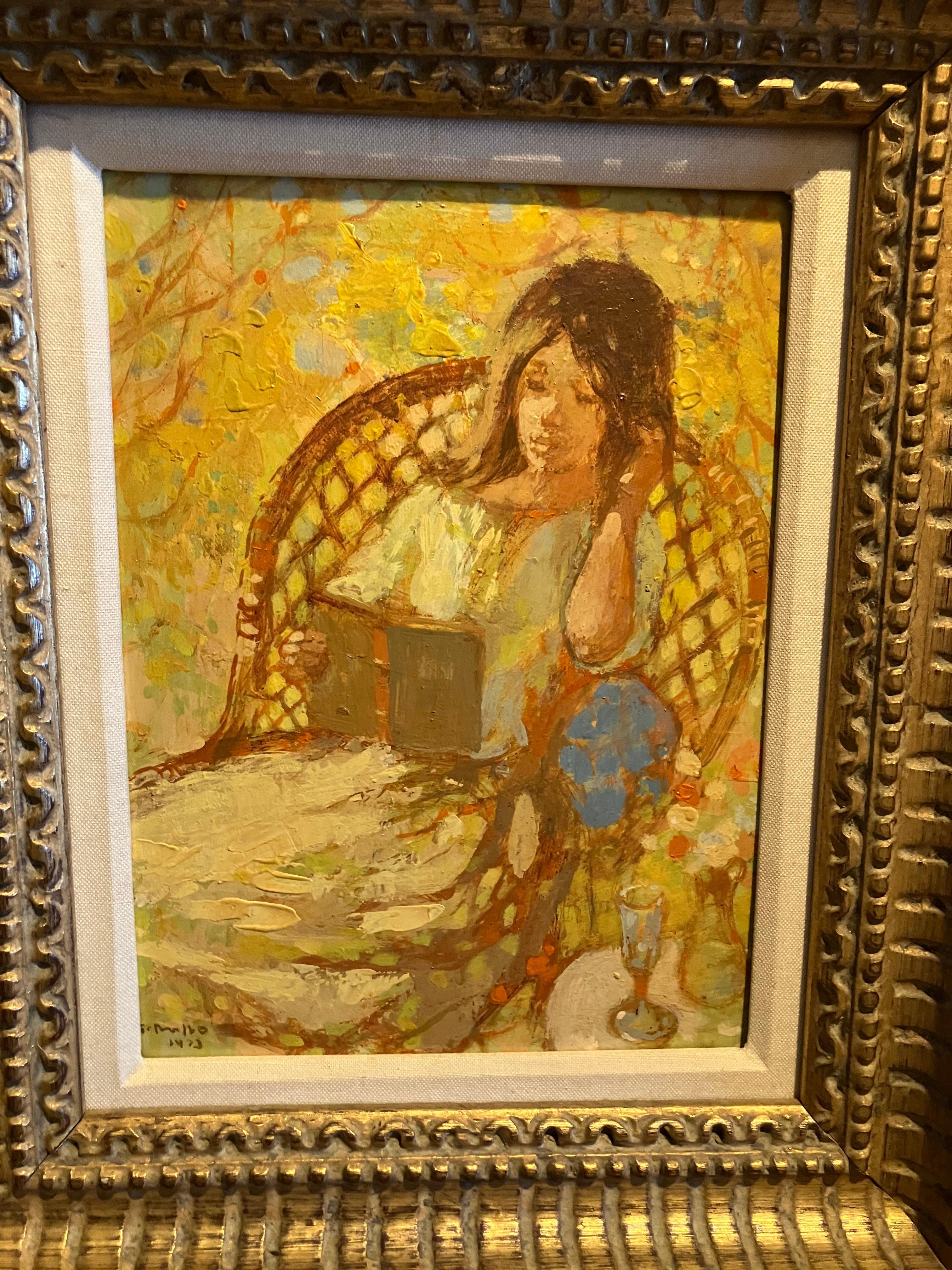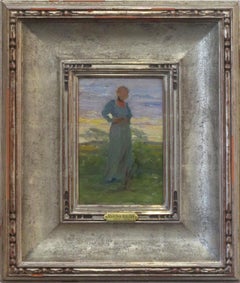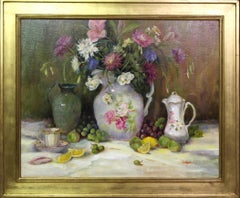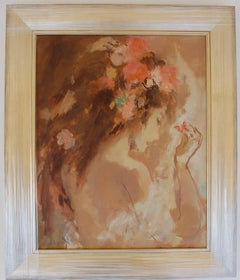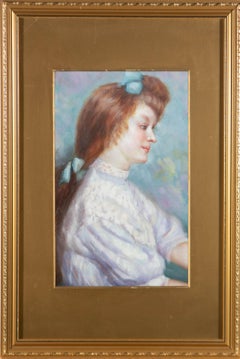Want more images or videos?
Request additional images or videos from the seller
1 of 8
Barbara A. WoodLullabyeCirca 1980
Circa 1980
$1,200
£934.26
€1,062.40
CA$1,725.26
A$1,894.67
CHF 989.43
MX$22,613.66
NOK 12,535.15
SEK 11,683.25
DKK 7,934.76
About the Item
This artwork is an original seriolithograph (serigraph with lithograph) by American artist Barbara A. wood, born 1926. It is hand signed and numbered 257/260 in pencil by the artist. The image size is 16.5 x 20.25 inches, framed size is 30.75 x 34.75 inches. It is beautifully framed in a custom gold frame, with fabric matting and gold color bevel. It is in excellent condition.
Barbara A. Wood is a native of Ohio. She attended school in Toledo and graduated from high school with a scholarship to Traphagen School of Fashion in New York. Her instructors found her work so creative and expressive that they encouraged her to pursue fine arts.She enrolled and completed her formal studies at the famous Art Students’ League in New York. She moved to Southern California where she began postgraduate studies at the Otis Art Institute and the Pasadena School of Fine Arts.
Internationally known, she has had major one-person shows throughout the United States, Australia, Canada, and England. Her works are part of the collections of numerous celebrities as well as private collections throughout the world. Her paintings are in the collections of His Majesty the King of Saudi Arabia’s Private Office, President George H. W. Bush, Georgia Governor Sonny Perdue, Elizabeth Taylor, Hugh Hefner, Jane Seymour, Jerry Lewis, Mickey Rooney, Dick Van Dyke, Dennis Weaver, Art Linkletter, Ron Howard, Gavin MacLeod, and many others.
- Creator:Barbara A. Wood (1926, American)
- Creation Year:Circa 1980
- Dimensions:Height: 30.75 in (78.11 cm)Width: 34.75 in (88.27 cm)Depth: 1.75 in (4.45 cm)
- More Editions & Sizes:The image size is 16.5 x 20.25 inches, framed is 30.75 x 34.75 inchesPrice: $1,500
- Movement & Style:
- Period:
- Condition:
- Gallery Location:San Francisco, CA
- Reference Number:Seller: wood lullabye1stDibs: LU66632381471
Barbara A. Wood
Barbara A. Wood (American, b. 1926) was born and raised in Columbus, Ohio. Raised by her mother, grandmother, and great-grandmother, the personalities and hardships within each woman became the catalyst for her art. As an only child and quite often bedridden with bouts of pneumonia, Barbara spent most of her time painting alone. She attended school in Toledo and graduated from high school with a scholarship to Traphagen School of Fashion in New York. Her instructors found her work so creative and expressive that they encouraged her to pursue fine arts. She enrolled and completed her formal studies at the Art Students League in New York. She later married and moved to Southern California. She began postgraduate studies at the Otis Art Institute and the Pasadena School of Fine Arts. Wood has had major one-person shows throughout the United States, Australia, Canada, and London. Her works are part of the collections of numerous celebrities as well as private collections throughout the world. Her paintings are in the collections of the King of Saudi Arabia, President George H. W. Bush, Georgia Governor Sonny Perdue, Elizabeth Taylor, Hugh Hefner, Jane Seymour, Jerry Lewis, Mickey Rooney, Dick Van Dyke, Dennis Weaver, Art Linkletter, Ron Howard, Gavin MacLeod, and many others. Artist’s Statement: Painting, to me, is a joy, a challenge, a fulfillment, and a love affair. It is a vehicle for expressing impressions I have drawn from a tangible world, where color is the music of painting.
About the Seller
5.0
Platinum Seller
Premium sellers with a 4.7+ rating and 24-hour response times
Established in 1999
1stDibs seller since 2017
864 sales on 1stDibs
Typical response time: <1 hour
- ShippingRetrieving quote...Shipping from: San Francisco, CA
- Return Policy
More From This Seller
View AllPensive Woman
By Barbara A. Wood
Located in San Francisco, CA
This artwork Titled "Pensive Woman" is an original seriolithograph (serigraph with lithograph) by American artist Barbara A. wood, born 1926. It is hand ...
Category
Late 20th Century Modern Figurative Prints
Materials
Other Medium
Cherish One
By Don Hatfield
Located in San Francisco, CA
This artwork titled "Cherish One" 1992 is an original color serigraph on heavy Coventry paper by noted American artist Donald (Don) Hatfield, b.1947. It is hand signed and numbered 3...
Category
Late 20th Century American Impressionist Figurative Prints
Materials
Screen
Mother and Children
By Edna Hibel
Located in San Francisco, CA
This artwork "Mother and Children" c.1970, is a colors lithograph on paper by American artist Edna Hibel, 1917-2014. It is signed and numbered II 3/10 Ed. 200 in pencil by the artist. The The artwork (sheet ) size is 34 x 23 inches, framed size is 40 x 29 inches. Custom framed in original wooden decorated grey/silver frame. It is in excellent condition.
About the artist:
Edna Hibel, a painter of sentimental pictures of children, has had a more than 60-year career as painter and lithographer and promoter of peace through exhibitions of her artwork.
She was born in 1917 in Boston, Massachusetts. Her parents were Abraham and Lena Hibel, and she was raised in the Boston area and educated at Brookline High School where she met her future husband, Theodore Plotkin.
She began to paint when she was nine years old and learned watercolor during summers at the shore where her family vacationed in Maine and Hull, Massachusetts.
Hibel studied at the Boston Museum School of Fine Arts, from 1935-39, receiving a Sturtevant Traveling Fellowship to Mexico. In Boston, in 1966, she began lithography, continuing in 1970 in Zurich, where she still works every year. She has created lithographic works with up to 32 stones (or colors) on paper, silk, wood veneer and porcelain. The latter pieces are called lithographs on porcelain and result from a complicated process, that she keeps a secret, whereby she transfers stone lithographic color separations onto Bavarian hard paste porcelain. Hibel has created the "Arte Ovale" series and various plaques with this technique.
She organized the Edna Hibel Museum of Art, in Jupiter, Florida, to display and promote her work and also created a United Nations stamp, "Mother Earth."
In 1995, she was commissioned by the Foundation of the U.S. National Archives to commemorate the 75th anniversary of women receiving the universal right to vote. At the ceremony, Ms. Lucy Baines Johnson referred to Hibel as the "Heart and Conscience of America."
In November, 2001, the World Cultural Council based in Mexico City gave her the Leonardo da Vinci World Award of Arts.
Hibel's work has been exhibited in museums and galleries in more than 20 countries including Russia, Brazil, China, Costa Rica, and the United States, and under the royal patronage of Count and Countess Bernadotte of Germany, Count Thor Bonde of Sweden, Prince and the late Princess Rainier of Monaco and Her Majesty Queen Elizabeth II of England.
Pope John Paul II gave her a medal of honor as did the late Belgian King Baudouin. She also received honorary Doctoral degrees including from Eureka College, and Northwood University of Florida, Michigan and Texas. She also has received many humanitarian honors for her charitable efforts for children's and medical charities.
Her exhibitions "Golden Bridge" and " Peace Through Wisdom" were efforts to promote peace and cultural understanding between China, the United States, Yugoslavia and Russia, and a television documentary titled "Hibel's Russian Palette" was based on her trips and art shows in Leningrad, now St. Petersburg. In 2001, Edna received a Lifetime Achievement Award from "Women in the Visual Arts," an organization of artists in the South Florida area.
Works in Permanent Collections:
Harvard University
Boston University
Museum of Fine Arts, Boston
Springfield Museum of Arts, Massachusetts
University of New Hampshire
Fleischmann Collection, Cincinnati
Detroit Art Institute
Milwaukee Art Museum
Phoenix Art Museum
La Jolla Museum, California
Lowe Gallery, University of Miami, Florida
Columbus Museum of Arts and Crafts, Georgia
WarrenHall Coutts, Ill, Memorial Museum of Art, El Dorado, Kansas
Palais des Nations,Geneva, Switzerland
United Nations Headquarters, New York City
Norton Gallery, West Palm Beach, Florida
de Saisset Museum, Santa Clara, California
Russian Academy of Art, St. Petersburg, Russia
Hibel Museum of Art, Lake Worth, Florida
One Artist Exhibitions:
Shacknow Museum of Fine Arts, Plantation, Florida, 2000
Cornell Museum of Art and History, Delray Beach, Florida, 1999 (and 1993)
Klutznick National Jewish Museum, Washington, D.C., 1999
The Museum of Printing History, Houston, Texas, 1999 (and 1998)
Mitsukoshi Fine Art Gallery, Tokyo, Japan, 1995 (and 1994)
Lyme Academy of Fine Art, Old Lyme, Connecticut, 1994
Grenchen Art Museum, and Galerie BrechbUhl, Grenchen, Switzerland, 1992
Soviet Union Academy of Art, and Exhibition Hall of the Russian Union of Artists, Leningrad (St. Petersburg),
Russia, U.S.S.R., 1990
Northern Indiana Arts Association Gallery, Munste~ Indiana, 1990
Galerie Vindobona, Bad Kissingen,West Germany, 1988
The National Museum of Women in the Arts, Washington, D.C., 1989
St. Peter An...
Category
Late 20th Century American Impressionist Figurative Prints
Materials
Lithograph
Woman Sitting
By Barbara A. Wood
Located in San Francisco, CA
This artwork "Woman Sitting" c.1990 is an offset lithograph by American artist Barbara A. wood, born 1926. It is hand signed and numbered 222/975 in penc...
Category
Late 20th Century Modern Figurative Prints
Materials
Lithograph
Chinese Girl
By Edna Hibel
Located in San Francisco, CA
This artwork "Chinese Girl" c.1970, is a colors lithograph on Japan nacre paper by American artist Edna Hibel, 1917-2014. It is signed and inscribed Artist Proof in pencil by the art...
Category
Late 20th Century American Impressionist Figurative Prints
Materials
Lithograph
Intermission
By Barbara A. Wood
Located in San Francisco, CA
This artwork "Intermission" 1995 is an original colors serigraph by American artist Barbara A. wood, born 1926. It is hand signed and numbered 251/350 in pencil by the artist. The a...
Category
Late 20th Century Modern Figurative Prints
Materials
Screen
You May Also Like
"Lady of Summer"
By Martha Walter
Located in Lambertville, NJ
Jim’s of Lambertville is proud to offer this artwork by:
Martha Walter (1875-1976)
Born in Philadelphia in 1875, Martha Walter attended Girls’ High School followed by the Pennsylva...
Category
Early 1900s American Impressionist Landscape Paintings
Materials
Oil, Board
Thoughts of Home, 24x30" oil, framed
By Lu Haskew
Located in Loveland, CO
Thoughts of Home by Lu Haskew
Oil 24x30" image size, 30x36" framed (wood with gold leaf)
Still life with flowers and fruit amongst a porcelain tea s...
Category
Early 2000s American Impressionist Interior Paintings
Materials
Canvas, Oil
Dream Mystique
By Wallace Bassford
Located in Lake Worth Beach, FL
Dream Mystique
Artist signed and titled, new frame canvas 24x20
Wallace Bassford was an American painter and illustrator, born in 1900 in St. Louis Missouri, he attended the St. Loui...
Category
1970s Expressionist Figurative Paintings
Materials
Oil, Canvas
Impressionist Mid 20th Century Oil - Pretty Edwardian Woman
Located in Corsham, GB
A wonderful portrait of a young woman with long red hair. The artist has wonderfully captured the sitter in a relaxed pose, she wears a high neck lilac b...
Category
20th Century Portrait Paintings
Materials
Oil
$375 Sale Price
20% Off
Germano Russo Impressionist Young Beauty
By Germano Russo
Located in San Francisco, CA
Beautifully executed heavy impasto impressionist painting by the Italian artist Germano Russo. He was born in 1935 in Florence Italy. This young lady, reading a book, reminds me of t...
Category
1970s Impressionist Figurative Paintings
Materials
Oil
Pierre Cornu (1895-1996) French Post Impressionist Oil Painting
By Pierre Cornu
Located in Holywell, GB
Pierre Cornu (1895-1996)
A delightful painting of a reclining woman by the master of colour and light, Pierre Cornu. Fully signed and endorsed verso with the Artelier’s stamp.
Pierr...
Category
1960s Post-Impressionist Figurative Paintings
Materials
Oil
More Ways To Browse
Pamela Bianco
Paolo Toschi
Paris Street Scene Lithograph
Paul Stewart
Pe Felix
Peter Mats
Peter Max 1971
Peter Max 1973
Picasso Ecuyere
Picasso Farol
Picasso Lithograph Bathers
Picasso Lithograph Couple
Picasso Marlborough
Picasso Pencil Signed
Picasso Plates Signed
Picasso Series 156
Picasso Toros Vallauris
Picasso Woman With Hat
